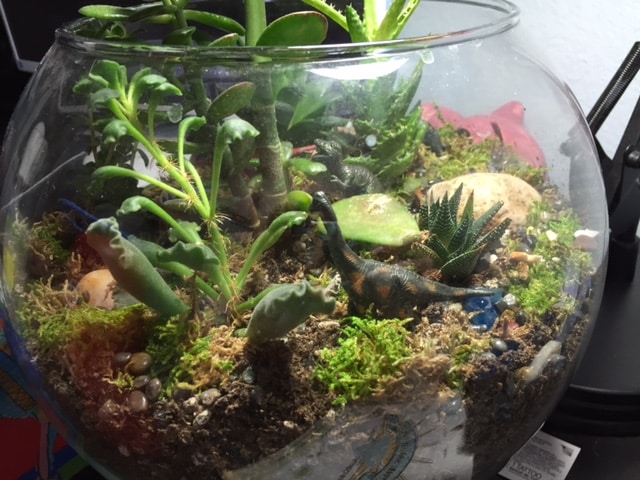Looking for a fun science project that will last? Plant a terrarium garden with your kids. Such mini gardens grow well indoors and keep teaching children lessons long after school grades are received. Gardening is an activity that imparts valuable skills, including responsibility for other living things that can eventually translate into stewardship of our planet.
Thirteen-year-old Logan keeps his dinosaur terrarium in his bedroom, where he can always see it. “The terrarium is right next to my bed, and I can look at it while I’m working on my computer,” he says.

Logan enjoyed making the terrarium, because it enabled him to express his creativity, and he enjoys science, especially studying paleontology.
Here are Logan’s tips for creating a kid’s terrarium garden.
Start with a theme. Having a plan when it comes to the terrarium allows you and your child to create a scene that tells a story. Let your imaginations run wild and brainstorm. Options include a dinosaur kingdom, mermaids, beach scene, forest full of elves and the depiction of a favorite fairytale or a holiday. Logan suggests thinking of your favorite things and then picking one.
Choose your plants. Buy plants that fit your theme. Logan says he chose succulents, because they look like prehistoric plants. If you’re doing a beach scene, use small palm trees. Whatever plants you do choose, make sure they are slow growing and suited for terrariums.
Making a closed terrarium is a similar process that can be found here.
Decorate. Add decorative accessories to the terrarium like figurines, tiny furniture and decorative rocks, gravel and marbles.
Place in bright light. Most terrariums do best in bright, but not direct light. Locate a few feet from a sunny window, or under artificial lighting. Logan has his garden under a full-spectrum light he keeps on from 8 am to 8 pm daily.
Water properly. Avoid overwatering your terrarium, as that will quickly lead to root rot. This is especially important when growing succulents indoors. Water occasionally using a turkey baster filled with lukewarm water. Use the tip of the baster to direct the water into the soil and away from the leaves, which you want to keep dry to avoid diseases.
Fertilize rarely. Because you don’t want terrarium plants to grow quickly, you should generally avoid fertilizing. Feed only if the plants seem to be nutrient deficient, which is generally indicated by yellowing leaves and sparse and disfigured growth.
Julie Bawden-Davis is a garden writer and master gardener, who since 1985 has written for publications such as Organic Gardening, Wildflower, Better Homes and Gardens and The Los Angeles Times. She is the author of seven books, including Reader’s Digest Flower Gardening, Fairy Gardening, The Strawberry Story, and Indoor Gardening the Organic Way, and is the founder of HealthyHouseplants.com.

